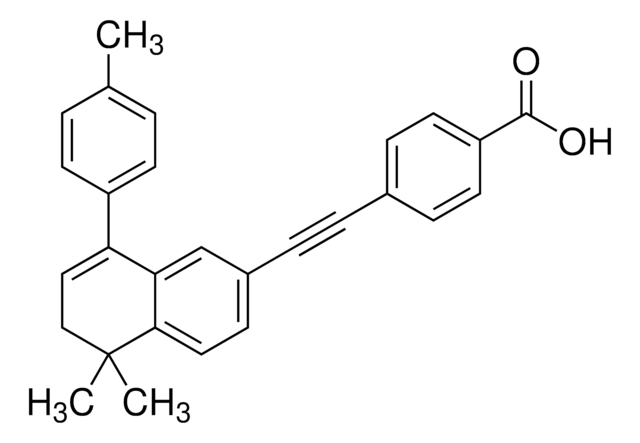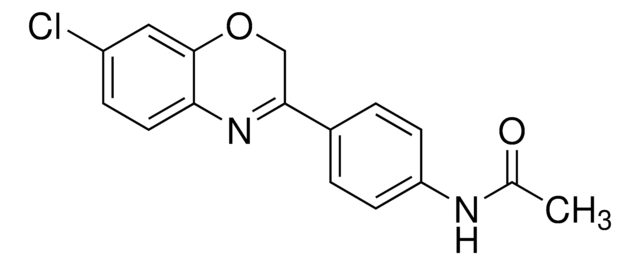SML0921
AR7
≥98% (HPLC)
Synonym(s):
7-Chloro-3-(4-methylphenyl)-2H-1,4-benzoxazine; 7-Chloro-3-p-tolyl-2H-benzo[b][1,4]oxazine, Atypical retinoid 7
Sign Into View Organizational & Contract Pricing
All Photos(1)
About This Item
Empirical Formula (Hill Notation):
C15H12ClNO
CAS Number:
Molecular Weight:
257.71
UNSPSC Code:
12352200
NACRES:
NA.77
Recommended Products
Quality Level
Assay
≥98% (HPLC)
form
powder
color
white to beige
solubility
DMSO: 20 mg/mL, clear
storage temp.
2-8°C
Application
AR7 has been used:
- as chaperone-mediated autophagy (CMA) activator to study the activity of CMA in rat liver lysosomes
- as a CMA activator to study its effects on expression of DEAD-box helicase 3 X-linked (DDX3X), eukaryotic translation initiation factor 4A1 (EIF4A1), and eukaryotic translation initiation factor 4H (EIF4H) in cancer cells
- to study its effects on synuclein α (SNCA) oligomer levels in mature primary cortical neurons
Biochem/physiol Actions
AR7 is an atypical retinoic acid receptor α (RARα) antagonist. There is high interest in retinoic acid receptors for cancer and for differentiation studies. Recently, it has been found that signaling through retinoic acid receptor α (RARα) inhibits chaperone-mediated autophagy (CMA). Disruption of RARα signaling has a stimulatory effect on CMA, but can lead to inhibition of macroautophagy. AR7 antagonizes only the CMA inhibitory effect without affecting macroautophagy, allowing the two RARα effects on autophagy to be studied independently.
Signal Word
Warning
Hazard Statements
Precautionary Statements
Hazard Classifications
Aquatic Acute 1 - Aquatic Chronic 1
Storage Class Code
11 - Combustible Solids
WGK
WGK 3
Flash Point(F)
Not applicable
Flash Point(C)
Not applicable
Certificates of Analysis (COA)
Search for Certificates of Analysis (COA) by entering the products Lot/Batch Number. Lot and Batch Numbers can be found on a product’s label following the words ‘Lot’ or ‘Batch’.
Already Own This Product?
Find documentation for the products that you have recently purchased in the Document Library.
You-Jin Choi et al.
Molecular metabolism, 76, 101784-101784 (2023-08-01)
Alterations in lipid metabolism are associated with aging and age-related diseases. Chaperone-mediated autophagy (CMA) is a lysosome-dependent process involved in specific protein degradation. Heat shock cognate 71 kDa protein (Hsc70) recognizes cytosolic proteins with KFERQ motif and allows them to enter
Y R Juste et al.
Methods in molecular biology (Clifton, N.J.), 1880, 703-727 (2019-01-06)
Chaperone-mediated autophagy (CMA) is a selective type of autophagy whereby a specific subset of intracellular proteins is targeted to the lysosome for degradation. These proteins are identified by a chaperone that targets them to lysosomes. There, they are translocated into
Yuqing Hao et al.
Autophagy, 15(9), 1558-1571 (2019-03-02)
Chaperone-mediated autophagy (CMA) is a lysosomal degradation pathway of select soluble proteins. Nearly one-third of the soluble proteins are predicted to be recognized by this pathway, yet only a minor fraction of this proteome has been identified as CMA substrates
Panagiota Mavroeidi et al.
Autophagy, 18(9), 2104-2133 (2022-01-11)
Accumulation of the neuronal protein SNCA/alpha-synuclein and of the oligodendroglial phosphoprotein TPPP/p25A within the glial cytoplasmic inclusions (GCIs) represents the key histophathological hallmark of multiple system atrophy (MSA). Even though the levels/distribution of both oligodendroglial SNCA and TPPP/p25A proteins are
Alba Navarro-Romero et al.
NPJ Parkinson's disease, 8(1), 126-126 (2022-10-07)
Mutations in the GBA gene that encodes the lysosomal enzyme β-glucocerebrosidase (GCase) are a major genetic risk factor for Parkinson's disease (PD). In this study, we generated a set of differentiated and stable human dopaminergic cell lines that express the
Our team of scientists has experience in all areas of research including Life Science, Material Science, Chemical Synthesis, Chromatography, Analytical and many others.
Contact Technical Service









